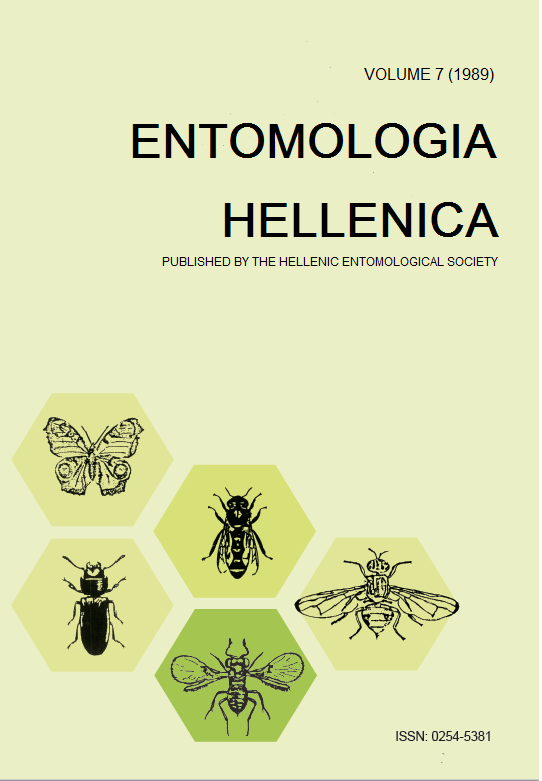Καταπολέμηση Εχθρών των Οπωροφόρων και Φυτών Μεγάλης Καλλιέργειας με το Hexaflumuron στη Β. Ελλάδα
Περίληψη
Πειράματα έγιναν με το hexaflumuron κατά εχθρών της μηλιάς, αχλαδιάς, ροδακινιάς, πατάτας και του καλαμποκιού. Στη μηλιά χρησιμοποιήθηκε ένα πρόγραμμα προκαθορισμένων ψεκασμών για τη σύγχρονη καταπολέμηση της καρποκάψας, Cydia pomonella (L.), των φυλλορυκτών, Phyllonorycter blancardella (Fabr.), Ρ. corylifoliella (Hbn.), και Leucoptera scitella (Zell.) και του φυλλοδέτη Adoxophyes orana (F.v. Roslerstamm). Κατά της ψύλλας της αχλαδιάς Cacopsyllu pyri L., του βλαστορύκτη της ροδακινιάς, Anarsia lineatella Zell. και της καρποκάψας της ροδακινιάς, Grapholitha molesta (Busck) τα πειράματα έγιναν για να προσδιορισθεί η αποτελεσματικότητα και ο χρόνος εφαρμογής, ενώ οι δοκιμές εναντίον του δορυφόρου της πατάτας, Lepiinotarsa decemlineata (Say) και του εντόμου του καλαμποκιού Sesamia nonagrioides Lef. έγιναν μόνο για αποτελεσματικότητα.
To hexaflumuron υπόσχεται να είναι ένα εντομοκτόνο με εξαιρετικά καλή αποτελεσματικότητα αφού στα πειράματα ήταν τουλάχιστον τόσο καλό όσο τα οργανοφωσφορικά εντομοκτόνα, το amitraz και οι βενζοϋλοφαινυλικές ουρίες (BPU) που εδοκιμάσθηκαν. Με λιγότερους ψεκασμούς έδωσε συνδυασμένη καταπολέμηση εχθρών της μηλιάς για όλη τη θερινή περίοδο. Είναι μια νέα βενζοϋλοφαινυλουρία, μικρής τοξικότητας στα θηλαστικά, τα ωφέλιμα παράσιτα και τα αρπακτικά των εντόμων και ταιριάζει σε προγράμματα ολοκληρωμένης
καταπολέμησης. Το hexaflumuron δεν είχε καμμιά επίδραση στα ακμαία του αρπακτικού Coccinella septempunctata L. στη δοκιμή της πατάτας. Οι ψεκασμοί πρέπει να αρχίζουν στην αρχή της ωοτοκίας για τους εχθρούς που προκαλούν ζημιές στο φρούτο και στο στάδιο του αυγού ή της προνύμφης-νύμφης για τους εχθρούς που προκαλούν ζημιές στο φύλλωμα. Οι ψεκασμοί πρέπει να καλύπτουν πλήρως τα φρούτα και το φύλλωμα.
Λεπτομέρειες άρθρου
- Πώς να δημιουργήσετε Αναφορές
-
Komblas Κ. Ν., Tsakonas, P., Lysandrou, M., & Elia Τ. Κ. (1989). Καταπολέμηση Εχθρών των Οπωροφόρων και Φυτών Μεγάλης Καλλιέργειας με το Hexaflumuron στη Β. Ελλάδα. ENTOMOLOGIA HELLENICA, 7, 35–41. https://doi.org/10.12681/eh.13967
- Τεύχος
- Τόμ. 7 (1989)
- Ενότητα
- Articles

Αυτή η εργασία είναι αδειοδοτημένη υπό το CC Αναφορά Δημιουργού – Μη Εμπορική Χρήση – Παρόμοια Διανομή 4.0.
Authors who publish with this journal agree to the following terms:
Authors retain copyright and grant the journal right of first publication with the work simultaneously licensed under a Creative Commons 4.0 license.
Authors are able to enter into separate, additional contractual arrangements for the non-exclusive distribution of the journal's published version of the work (e.g. post it to an institutional repository or publish it in a book), with an acknowledgement of its initial publication in this journal. Authors are permitted and encouraged to post their work online (preferably in institutional repositories or on their website) prior to and during the submission process, as it can lead to productive exchanges, as well as earlier and greater citation of published work.



